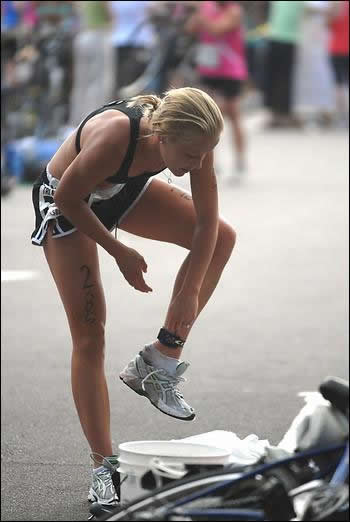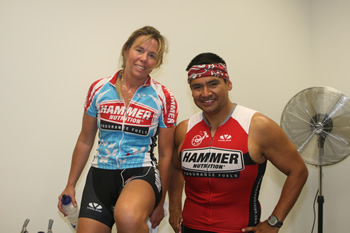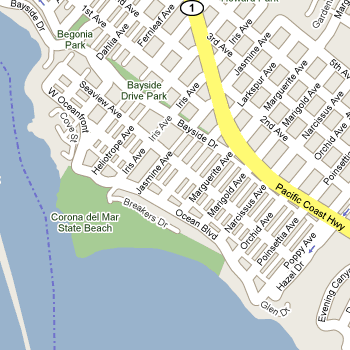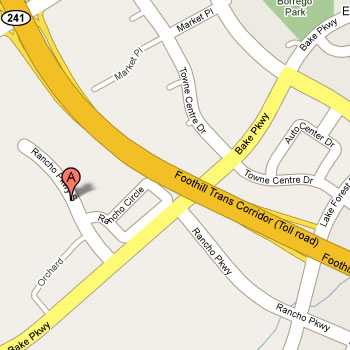TIPS FOR TINY TRANSITION TIMES
Jarrett Pflieger
 What if there was a way to shave seconds, or even minutes, off your race times without doing a thing to your current training regimen? Sounds too good to be true, right? Wrong.
What if there was a way to shave seconds, or even minutes, off your race times without doing a thing to your current training regimen? Sounds too good to be true, right? Wrong.
Practicing and mastering transitions is by far the easiest way to shave time off your triathlon races. With how competitive age group racing has become, even a few seconds could be the difference between a medal around your neck, or a sour taste in your mouth. Lets look at five things you can do to speed your way through T1 and T2 and gain time on your competition.
Transition tip #1: Practice!
It does not matter if you know exactly what to do and have ran through it 1,000 times in your head. If you are in the middle of a race with your heart pounding out of your chest, nerves racing, and blood pumping, 95% of the time you will screw up something if you do not practice it.
You need to practice unzipping and pulling off your wetsuit in a fatigued state, taking your bike/run shoes off and on, putting on your helmet and sunglasses, getting on and off your bike safely and quickly, etc. Even simple motor tasks become difficult when you are under pressure. Developing muscle memory through practice will make it second nature for you to perform these tasks in any situation, even under extreme stress.
Transition tip #2: Lube up
If you are wearing a wetsuit in your race, which you should be, it is very important to be able to take it off quickly in transition. If you struggle to get the thing off, it will negate any advantage you gained in the swim by wearing it.
Put some Body Glide or baby oil around your calves/ankles as well as your wrists/forearms. This will help the wetsuit slide off your body without you having to struggle. Don’t be the person wiggling and thrashing around on the ground after they fell over trying to get their feet out of the wetsuit. Along with lube, a proper fitting wetsuit is also important.
Transition tip #3: Place equipment properly
If you are one of those people that bring a king size beach towel and have all your stuff strewn all over, just stop it. You only need something about the size of a small workout towel for your gear. Having everything compact and close together will eliminate wasted time searching and moving around to get things. Your fellow racers will thank you too.
Your towel should be organized like this from top to bottom:
-Running shoes with socks (optional) on top of your shoes. Not wearing socks will save a few seconds, but don’t do it unless you have been trained without socks without any problems. If you wear a hat during the run, place it on top of your shoes so it’s the first thing you put on. If you wear a nutrition belt you can put that on top of your shoes also. Just make sure the straps are wide open so all you have to do is grab, wrap, and snap. Some people put their race belt on under their wetsuit so they don’t ever have to mess with it.
-Cycling shoes (if you don’t strap them to your bike) with your helmet resting on top with straps pulled out and fully extended.
-Sunglasses and race belt should go inside your helmet in a position that makes them easy to put on without fumbling around.
Some people put their helmet on top of their bike. This works well, until the person next to you bumps the bike rack or your bike and your helmet falls off and rolls away from your transition area.
Transition tip #4: Clip your cycling shoes into your bike before the race
Disclaimer: This is the tip that requires the most practice to truly master. Please do not attempt unless you are confident in your athletic ability and bike handling skills.
The technique of having your bike shoes already clipped in before the race will save time by allowing you to just put your helmet on, grab your bike, and go. You will run out of transition barefoot, mount your bike, and pedal with your feet on top of your shoes. Once you get moving on a flat stretch of ground, well clear of the mount line, you can bend down and strap each foot in. Make sure there are no riders around you and you are not on an uphill or steep downhill section. If you have to ride a while before you find a good flat stretch of ground, no problem. You’re still gaining ground on people trying to put their shoes on in transition and run with their clunky cleats.
To keep your shoes from dragging on the ground, put a thin rubber band through the loop on the heel of one shoe and hook it to your quick release lever on the rear wheel. This will keep your shoes in a fixed position until you start pedaling and the rubber band snaps.
Transition tip #5: Don’t sit. Stand or kneel.
The goal in transition is to save time; there is no place for sitting in a race. Sometimes standing can also be difficult when you’re tired and/or dizzy after the swim. When you dip your head down to put your shoes on and pick up any other gear you need, a massive head rush may ensue and you could end up taking an unintended nap for a bit.
An alternative method is to get down on one knee like you are proposing to the bike rack, place your first shoe on the front foot, then switch and do the same to the other side. You will need to put another towel in front of your transition area to keep your knees from getting scraped up.
Hopefully these several tips will help you save some time in transition and give you a small edge. If you’ve ever tried to run someone in your age group down at the finish, but can’t quite bridge the gap, a few seconds saved in transition could have made the difference. These are not the only time saving strategies out there. Feel free to be creative and experiment in training to find what works for you. Happy training and racing!
CHALLENGED ATHLETES FOUNDATION
Ron Saetermoe
 The Challenged Athletes Foundation (CAF) was founded in 1997 by some very good friends (including Bob Babbitt of Competitor Magazine) after Jim MacLaren was hit by a car during the Orange County International Triathlon and paralyzed from the neck down.
The Challenged Athletes Foundation (CAF) was founded in 1997 by some very good friends (including Bob Babbitt of Competitor Magazine) after Jim MacLaren was hit by a car during the Orange County International Triathlon and paralyzed from the neck down.
Since that time CAF has raised over $21 million for athletes all over the world and changed thousands of lives.
Coming up on Tuesday, August 25th is the annual CAF fundraiser put on by the Orange County Triathlon Club (OCTC). Every year the event includes great company, great food, great prizes, great auction and a great time. This very worthwhile event isn’t to be missed.
Tickets are $25.00 in advance and $35.00 at the door.
Both OCTC members and non-members are invited to attend the event. For more information go to www.octriclub.com.
TRYING NEW STUFF
Ron Saetermoe
Where would we be if we never tried new stuff? Back in the dark ages, that’s where. Triathlon is one of those sports where many people are trying new stuff to gain that competitive edge . . . and I’m one of them.
Of course, you never want to try new stuff on race day; although we seem to repeat this mistake again and again. The time to try it is during your workouts and determine whether you think it will work on race day.
For example, a couple issues ago we did an article on Larry Davidson’s Ironman nutrition. I tried his secret elixir (Infinit) in practice and used it during the Vineman 70.3. I loved it and will now incorporate its use in my longer workouts and races.
I broke the rule recently, accidentally. I had Dan Plummer of Wheels on Wheels transport my bike back from Santa Rosa (great service by the way) and picked it up at Edge Cyclesports (great bike shop by the way) and let it sit the entire week. I often lose the love for my bike after a competition. Anyway, I didn’t get around to washing out my aero bottle, which I normally do in my dishwasher.
So while getting my stuff packed for the Pacific Coast Triathlon Saturday evening I noticed my dirty aero bottle. Since the dishwasher was empty I decided to wash it by hand (here’s where the mistake happened). I washed it out the best I could with soap and water and mounted it back on my bike.
Sunday morning I filled the bottle with water (I only use water in sprint distance races) and I was ready to go. Wrong!!! With the first sip I realized I’d made a BIG mistake . . . apparently I didn’t rinse the spongy thing well enough and the water tasted like dish soap!
What to do? I’m riding as hard as I can and I’m sweating like crazy. So I keep drinking. You can probably guess what happened next . . . yep, I’m spitting up soapy water.
This is just another example of not trying anything new when racing. Here’s one potential innovation in triathlon nutrition I think we can take off the list.
Cheers!
FREE GROUP WORKOUTS (week of August 3rd)
All of our group workouts are free to all members and non-members, so come on out!
We want everyone to enjoy our group workouts but we should clarify the intent. The intent of the group workouts is to “workout.” Yes, it includes a social element. Yes, your Triathica host is happy to give you tips. But please be aware that everyone there is attempting to get a workout in at his or her own pace. If we all go at the slowest person’s pace many people won’t be getting in a proper workout. We will attempt to pair you up with another athlete so you’re not left alone.
Week of August 3rd
Event: Group Swim
Place: Triathica flag at Big Corona near the lifeguard station next to the jetty
Day: Wednesday, August 5th
Time: 5:30 p.m.
Planned Workout: 1 – 3 loops around the buoys
Event: Group Ride
Place: Triathica HQ
Day: Saturday, August 8th
Time: 7:30 a.m.
Planned Workout: 1 loop around Santiago Canyon
Event: Group Run
Place: Triathica HQ
Day: Sunday, August 9th
Time: 7:00 a.m.
Planned Workout: 9 miles through Whiting Ranch
PETE & CORRINNE UPDATE #5
Kelli Whittaker
Another busy week for Pete and Corrinne “training like triathletes” at Triathica.
Pete says, “the biggest update of the week for me is that I have a race plan to closely follow now. I am looking forward to executing the swim, bike, run and strength training over the next 9 weeks.”
Pete worked out a lot this past week but says, “my favorite workout has been riding the course on the CompuTrainer and monitoring my progress through the report system. Looking at my previous results helps me to fine tune my pedal stroke and improve my Watts per Kilogram ratio.” He attributes his continued improvement on the bike to the data he can view during and after a CompuTrainer workout.

Unfortunately, Corrinne had a rough week. She went to Camp Pendleton on Tuesday to ride the Camp Pendleton Triathlon bike course, but on the ride she took a bad fall and broke her wrist. She said, “the fall was disappointing, but I got lucky that it was only my wrist. When I fell there was a lady that was walking by that helped me up, she took me to her house and actually drove me all the way back to San Clemente where I had parked my car because I couldn’t ride back.” When Corrinne got back to her car she realize that her car had been broken into and her wallet had been stolen. Corrinne said, “it was just a really bad day, but I am not going to let it get me down. This experience reminded me that the kindness of a stranger can really make a difference and I gained a new friendship with the lady that helped me.”
Corrinne was unable to train the rest of the week, but says that next week she will start riding on the CompuTrainers. She believes that “it’s a set back but its not going to defeat me. I am just going to get right back into it. This accident really made me take a step back and realize what I want and come up with alternative ways to make sure that I’m still successful”. She is not going to be able to race in the Camp Pendleton Triathlon coming up in a few weeks, but she said that she is still determined to compete in the Orange County Triathlon at the end of September. That is determination at its finest! Her next doctor’s appointment is this Thursday and she hopes for good news.
Pete says, “Corrinne’s accident makes me sad, but I know that she is going to bounce back, she is determined and I will help her in any way possible.”
Check back next week to see how Pete and Corrinne are doing on their road to triathlon glory.




